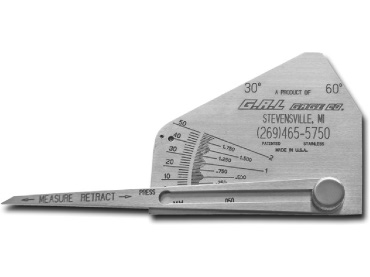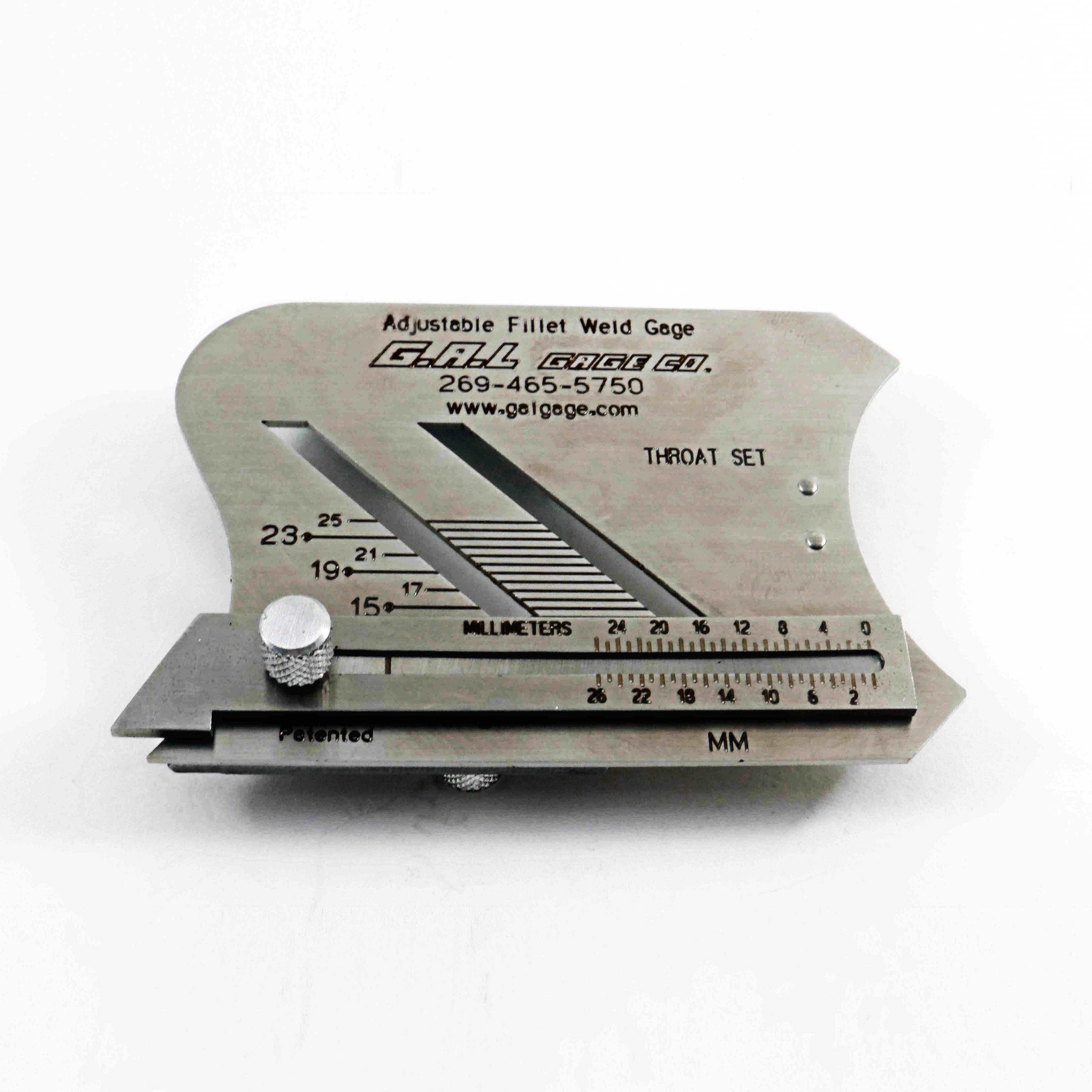Ingenious Methods to Fillet Weld Inspection and Testing: Enhancing Weld Quality and Compliance Specifications
In the realm of welding, the top quality and stability of fillet welds play a critical function in ensuring the architectural strength and dependability of numerous commercial components. With the constant drive for improved effectiveness and compliance with stringent requirements, the exploration of innovative approaches to fillet weld examination and testing has come to be imperative. As sectors develop, the standard techniques may no more be enough in fulfilling the demands of modern welding applications (Gauge Fillet Weld). By accepting cutting-edge modern technologies and approaches, a new perspective of opportunities arises in the world of weld quality analysis and adherence to compliance requirements.
Advanced Non-Destructive Screening Approaches
Using state-of-the-art innovations, progressed non-destructive testing techniques play a crucial function in guaranteeing the integrity and high quality of fillet welds. These techniques, such as phased array ultrasonic screening (PAUT) and magnetic fragment testing (MPT), deal in-depth insights right into the weld's inner framework without creating any type of damages to the material. PAUT, for example, utilizes several ultrasonic elements to evaluate the weld from different angles, providing an extensive visualization of prospective issues like absence of fusion or cracks.
By employing these sophisticated non-destructive screening methods, weld inspectors can accurately evaluate the top quality of fillet welds, ensuring compliance with sector criteria and policies. The ability to spot defects early on not just enhances weld top quality but additionally prevents expensive rework or failures in structural stability, highlighting the significance of these cutting-edge screening approaches in welding evaluations.
Robotics and Automation in Examination

The assimilation of robotics and automation has actually reinvented the inspection procedure for fillet welds, improving performance and accuracy in quality evaluation. Robotics use accurate control and repeatability in evaluating welds, guaranteeing constant and trusted results. Automated systems can be configured to comply with certain inspection courses, making sure extensive protection of welds and decreasing the threat of human error.
Robotic assessment systems furnished with advanced sensors can spot and gauge weld functions with high accuracy, offering thorough information for analysis. These systems can determine issues such as fractures, absence of combination, and porosity, making it possible for punctual corrective activities to be taken. Furthermore, robotics and automation allow for real-time information collection and evaluation, providing instant feedback to drivers and helping with quick decision-making processes.
In addition, making use of robotics and automation in fillet weld inspection improves general performance by lowering inspection times and boosting examination throughput. By streamlining the evaluation procedure, manufacturers can make sure weld high quality and conformity requirements are met successfully, eventually bring about set you back financial savings and boosted item quality.
Using Expert System for Evaluation
Expert system plays a critical function in boosting the effectiveness and accuracy of evaluation in fillet weld evaluation processes. By taking advantage of the power of AI, inspectors can streamline the analysis of weld top quality and compliance standards, leading to more precise and trusted outcomes. AI algorithms can swiftly process vast amounts of data from weld evaluations, finding defects or incongruities that might be challenging to identify with the nude eye. This advanced modern technology makes it possible for real-time tracking of weld high quality, permitting prompt rehabilitative activities to be taken if any type of issues are detected.
Additionally, AI systems can pick up from past evaluation information, consistently enhancing their capability to identify prospective flaws and discrepancies in fillet welds. This adaptive learning ability improves the general quality control procedure, reducing the likelihood of human mistake and making sure that welds satisfy the required requirements. By integrating artificial intelligence into fillet weld evaluation, markets can accomplish higher degrees of performance, uniformity, and compliance in their inspection methods.
Portable Equipment for On-Site Evaluation
Enhancing field assessment efficiency, the fostering of mobile devices changes on-site evaluation procedures for fillet welds. These devices offer versatility and comfort, enabling assessors to carry out extensive evaluations in different locations, including remote or tough environments. Portable devices such as ultrasonic testing devices, magnetic bit assessment devices, and digital radiography systems provide real-time information and high-resolution imaging capacities, enabling quick decision-making and instant responses on weld quality.
One substantial advantage of portable tools is their capacity to streamline inspection procedures, lowering downtime and enhancing overall efficiency - Gauge Fillet Weld. Assessors can conveniently transport these tools to different task websites, eliminating the demand for delivering hefty machinery or components to off-site centers. Additionally, the transportability of these tools promotes cost-effectiveness by minimizing transport expenses and speeding up assessment timelines
Furthermore, using portable tools for on-site evaluation promotes aggressive quality control measures, as assessors can you can try these out immediately identify and resolve any kind of potential welding flaws or inconsistencies. By including these innovative modern technologies right into on-site evaluation methods, welding experts can ensure compliance with sector requirements and enhance weld high quality, inevitably causing enhanced structural honesty and safety and security in different welding applications.
Combination of Information Administration Systems

Having actually maximized on-site examination processes through the utilization of portable devices, the following phase entails the seamless combination of information administration systems to additionally boost efficiency and data analysis abilities in fillet weld assessment and testing. By incorporating information monitoring systems into the browse around this site assessment process, organizations can enhance information collection, storage space, and analysis. This assimilation allows for real-time tracking of weld quality, instant identification of defects, and punctual decision-making to remedy any kind of issues that might develop during the inspection process.
Information management systems play an essential function in streamlining examination data, assisting in easy gain access to for authorized employees, and making sure data stability and safety. Through the combination of these systems, assessors can generate thorough records, track historical data for fad evaluation, and boost general procedure performance. The assimilation of data monitoring systems makes it possible for smooth communication between different stakeholders entailed in the examination procedure, fostering partnership and improving general high quality control actions. Eventually, the integration of data management systems offers to boost the requirements of fillet weld evaluation and screening, making sure compliance with industry laws and improving weld high quality.
Conclusion
Finally, innovative approaches to fillet weld inspection and testing have actually significantly enhanced weld top quality and compliance standards. Advanced non-destructive testing approaches, robotics, automation, artificial intelligence, mobile tools, and information monitoring systems have actually transformed the way weld evaluations are performed. By using these technologies, markets can ensure that welds meet the called for high quality requirements and laws, inevitably enhancing general efficiency and security in welding procedures.

Having optimized on-site examination processes via the utilization of mobile devices, the following phase entails the smooth integration of data monitoring systems to better enhance effectiveness and information evaluation capabilities in fillet weld examination and why not check here screening. Inevitably, the assimilation of information management systems serves to boost the standards of fillet weld inspection and screening, ensuring conformity with industry regulations and boosting weld high quality.
